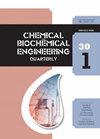Extraction Mechanism of Ferric and Manganese Ions with Aqueous Two-phase System Formed by Ionic Liquid and Polyethylene Glycol
IF 0.9
4区 生物学
Q4 BIOTECHNOLOGY & APPLIED MICROBIOLOGY
引用次数: 1
Abstract
In this work, we employed an aqueous two-phase system formed by an ionic liquid and polyethylene glycol for the separation of Fe(III), which is the most commonly used metal in the world, and Mn(II), which is currently used in many industries. We found that the extraction mechanisms of Fe(III) and Mn(II) were strongly influenced by the concentration of the hydrochloric acid that dissolved the metal salt. The ion pair reaction was the predominant mechanism that generated the Fe(III) and Mn(II) extractions. At a lower concentration of hydrochloric acid, metal ions were extracted because of the reaction between a metal cation and a dodecylsulfonate anion. At a higher concentration of hydrochloric acid, the reaction between a metal chlorocomplex anion and a hexylmethylimidazolium cation also proceeded. The aqueous two-phase system, composed of ionic liquid and polyethylene glycol, is promising for metal separation based on the difference in the affinity of metal with alkyl-sulfonate in a low HCl concentration and in the stability constant of metal chlorocomplex in a high HCl concentration. The maximum extractability of Fe(III) and Mn(III) was 57.8 and 75.3 %, respectively, with 0.3 mol dm–3 hydrochloric acid concentration.离子液体与聚乙二醇形成双水相体系萃取铁、锰离子的机理
在这项工作中,我们采用离子液体和聚乙二醇形成的水两相体系分离了世界上最常用的金属Fe(III)和Mn(II), Mn(II)目前在许多工业中使用。我们发现Fe(III)和Mn(II)的萃取机制受到溶解金属盐的盐酸浓度的强烈影响。离子对反应是Fe(III)和Mn(II)萃取的主要机理。在较低的盐酸浓度下,金属阳离子与十二烷基磺酸阴离子发生反应,金属离子被提取出来。在盐酸浓度较高时,金属氯络合物阴离子与己基甲基咪唑阳离子也发生了反应。由离子液体和聚乙二醇组成的双水相体系,在低HCl浓度下,金属与烷基磺酸盐的亲和力不同,在高HCl浓度下,金属氯配合物的稳定常数不同,是一种很有前景的金属分离体系。在0.3 mol dm-3盐酸浓度下,Fe(III)和Mn(III)的最大提取率分别为57.8%和75.3%。
本文章由计算机程序翻译,如有差异,请以英文原文为准。
求助全文
约1分钟内获得全文
求助全文
来源期刊
CiteScore
2.70
自引率
6.70%
发文量
23
审稿时长
>12 weeks
期刊介绍:
The journal provides an international forum for presentation of original papers, reviews and discussions on the latest developments in chemical and biochemical engineering. The scope of the journal is wide and no limitation except relevance to chemical and biochemical engineering is required.
The criteria for the acceptance of papers are originality, quality of work and clarity of style. All papers are subject to reviewing by at least two international experts (blind peer review).
The language of the journal is English. Final versions of the manuscripts are subject to metric (SI units and IUPAC recommendations) and English language reviewing.
Editor and Editorial board make the final decision about acceptance of a manuscript.
Page charges are excluded.

 求助内容:
求助内容: 应助结果提醒方式:
应助结果提醒方式:


